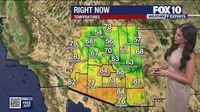As the last days of September 2025 unfolded, Arizona found itself battered by a relentless series of storms that left a trail of devastation across the state. What started as a typical end to the monsoon season quickly turned catastrophic, with heavy rainfall and flash floods claiming lives, damaging historic communities, and prompting a state of emergency in Gila County and beyond.
In Globe, a rural mining town with deep roots stretching back to the 19th century, the skies opened up with a fury rarely seen in recent memory. According to emergency officials cited by The Associated Press, about 2.5 inches of rain fell over 24 hours on September 26, 2025. This deluge inundated the town, forcing residents to scramble to rooftops for safety and washing out a local propane distributorship. The aftermath was a chaotic scene: roughly 1,000 residential-size propane tanks scattered throughout downtown, vehicles swept away by muddy torrents, and buildings battered by the floodwaters.
"There's propane tanks everywhere through downtown Globe," Carl Melford, emergency manager in Gila County, told reporters. Hazmat teams were dispatched to deal with the potentially explosive threat. "Luckily none of them ignited or exploded," Melford added, underscoring a rare stroke of luck amid the chaos.
The devastation was not limited to property. By the morning of September 27, at least four people had lost their lives due to the flooding. In Globe, two bodies were found in a vehicle and another was discovered in the floodwaters, according to Melford. Meanwhile, in suburban Phoenix, the Scottsdale Fire Department reported finding a person dead near a vehicle that had been submerged in about eight feet of fast-moving water the previous evening. The victim, identified as 38-year-old Ander Polanco, had been reported missing about an hour before his body was recovered. "His body was recovered from outside the vehicle once water levels had receded," Sgt. Allison Sempsis of the Scottsdale Police Department confirmed to The Arizona Republic.
As the storm raged, rescue operations became increasingly perilous. In the words of Globe Mayor Al Gameros, "Our primary, again, is search and rescue." Yet, persistent rain on September 27 temporarily halted the search for those possibly still missing, as high-flowing creeks made conditions too dangerous for crews. The city council declared an emergency, and officials pleaded with residents to stay away from the affected downtown area until it could be deemed safe. "Scores of people have stepped up to volunteer," Mayor Gameros noted, but authorities warned that uncoordinated volunteer efforts could hinder trained search dogs and rescue teams.
Just ten minutes west, the town of Miami faced its own ordeal. Streets flooded on September 27, but, as reported by emergency manager Carl Melford, no injuries occurred there. Still, the impact was significant enough that town officials declared a state of emergency and Miami Unified School District No. 40 canceled classes for September 29, citing both safety concerns and respect for families affected by the disaster. Superintendent Richard Ramos explained to parents, "Our number one priority is keeping our students and staff safe." The district began surveying Miami Junior Senior High School for possible damage, with further details promised once assessments were complete.
Elsewhere, the storms stranded about 20 tourists on the Havasupai Reservation, including at the world-famous Havasu Falls. The reservation, accessible only by foot, mule, or helicopter, lies deep in a gorge off the Grand Canyon and is known for its breathtaking blue-green waterfalls. Bureau of Indian Affairs dispatcher Shaileen Gonzales confirmed that all stranded visitors were safely evacuated, but the incident highlighted the risks that flash floods pose even in the state’s most remote and scenic locales.
In Phoenix, the Valley’s residents experienced their own share of drama as the skies unleashed 1.64 inches of rain at Sky Harbor International Airport on September 26. According to FOX 10 Phoenix, this brought the season's monsoon rainfall total to 2.55 inches—above average for the area. Temperatures dropped to a below-average high of 87 degrees Fahrenheit, a full 10 degrees cooler than the typical late-September day, offering a rare respite from the usual desert heat.
The storms triggered a cascade of emergencies across the metro area. Technical rescue teams responded to stranded motorists in Phoenix on September 27, pulling people from vehicles caught in flash floods near 44th Street and Indian School Road and again near 40th Street and Camelback Road. Fortunately, those rescued declined hospital treatment, but the close calls underscored the dangers posed by rapidly rising waters. As Captain Mike Johnson II of the Phoenix Fire Department explained, "Never drive into areas with flowing water; it takes less than 10 inches to wash a car away."
While the weather system responsible for the deluge was expected to move out of Arizona in the days following the floods, allowing for drier and calmer conditions, the recovery process was only just beginning. In Globe, business owners along Broad Street were finally permitted to return to their properties at noon on September 28, after search and rescue operations had stabilized. The city established drop-off sites for debris removal at several locations, including near the El Ranchito restaurant, Globe public library, and Highway 60 Motors, to help residents deal with the mud, wreckage, and scattered tanks left in the flood’s wake.
Governor Katie Hobbs issued a state of emergency for Gila County, mobilizing state resources to aid in recovery and signaling the seriousness of the disaster. The American Red Cross and local fire departments issued reminders about flood safety: "Turn around don’t drown! If you must drive and you encounter a flooded roadway, turn around and go another way," they advised, echoing a message that can mean the difference between life and death in flash flood conditions.
As Arizona’s communities begin the long process of cleanup and rebuilding, the events of late September serve as a stark reminder of nature’s power and unpredictability. From historic mining towns to bustling urban centers and remote tourist destinations, the floods of 2025 tested the resilience of Arizonans—and, in many cases, brought out the best in neighbors and first responders alike.
Though the monsoon season has drawn to a close, the lessons learned from these storms will linger long after the waters recede. Preparedness, caution, and a strong sense of community have proven vital in weathering both the literal and figurative storms that come Arizona’s way.





